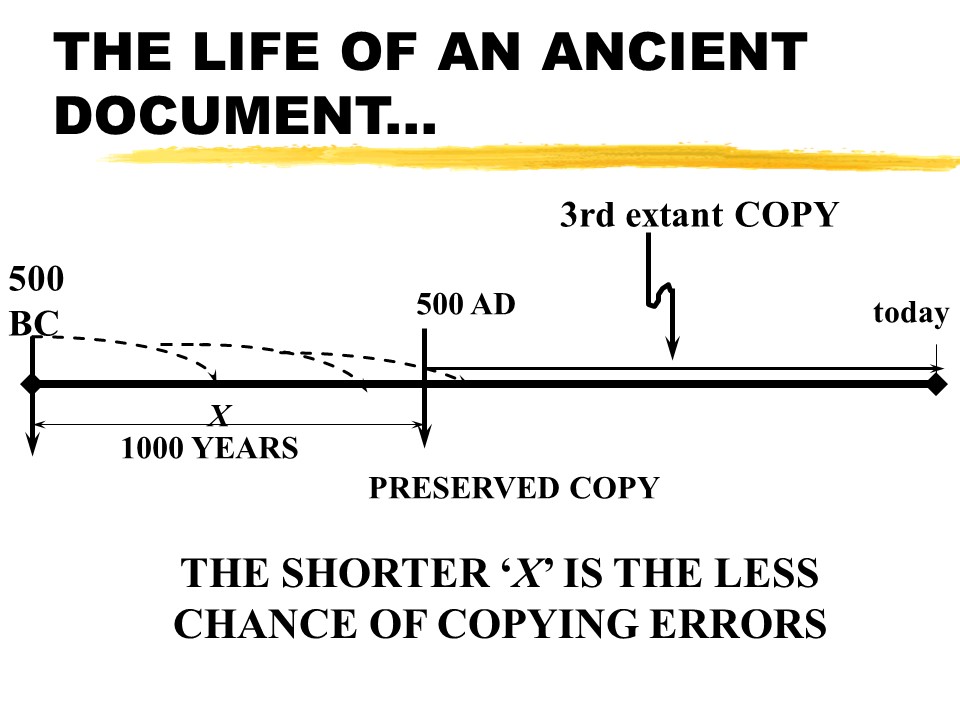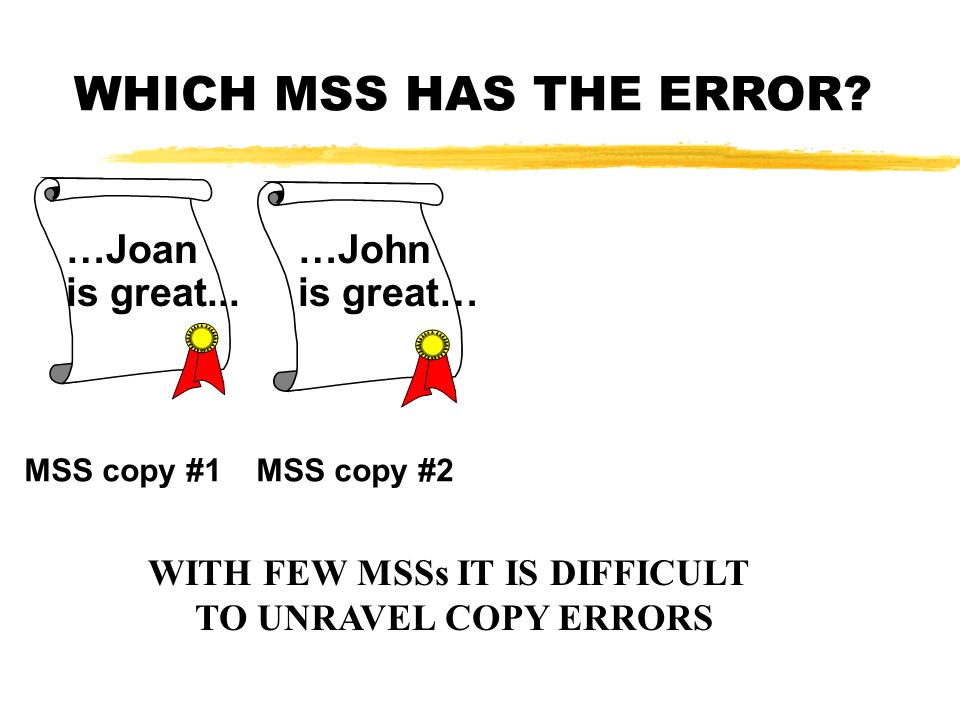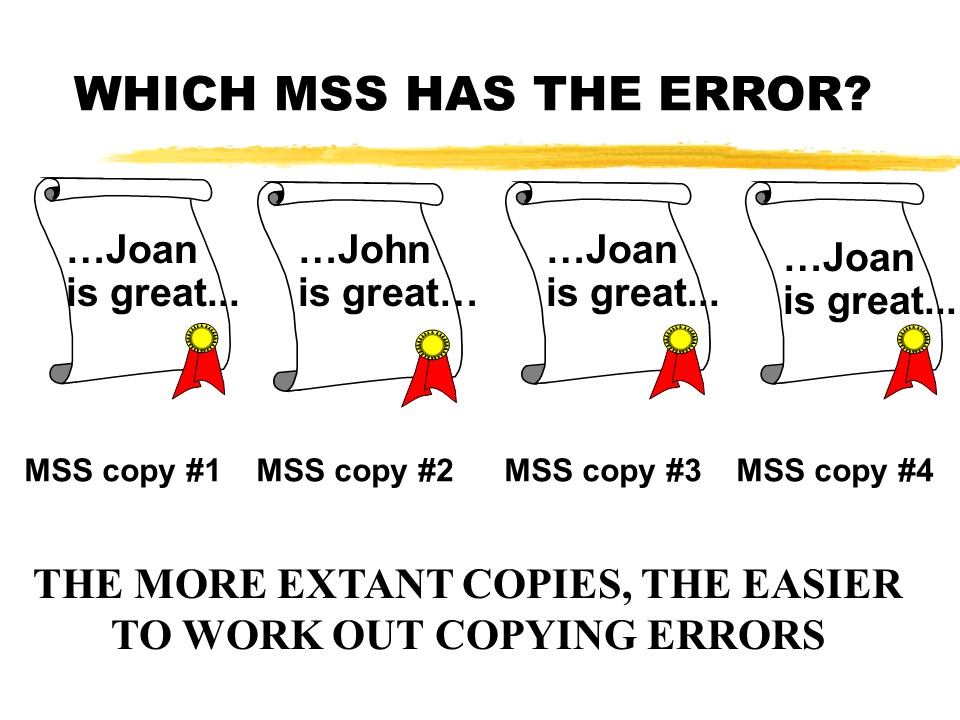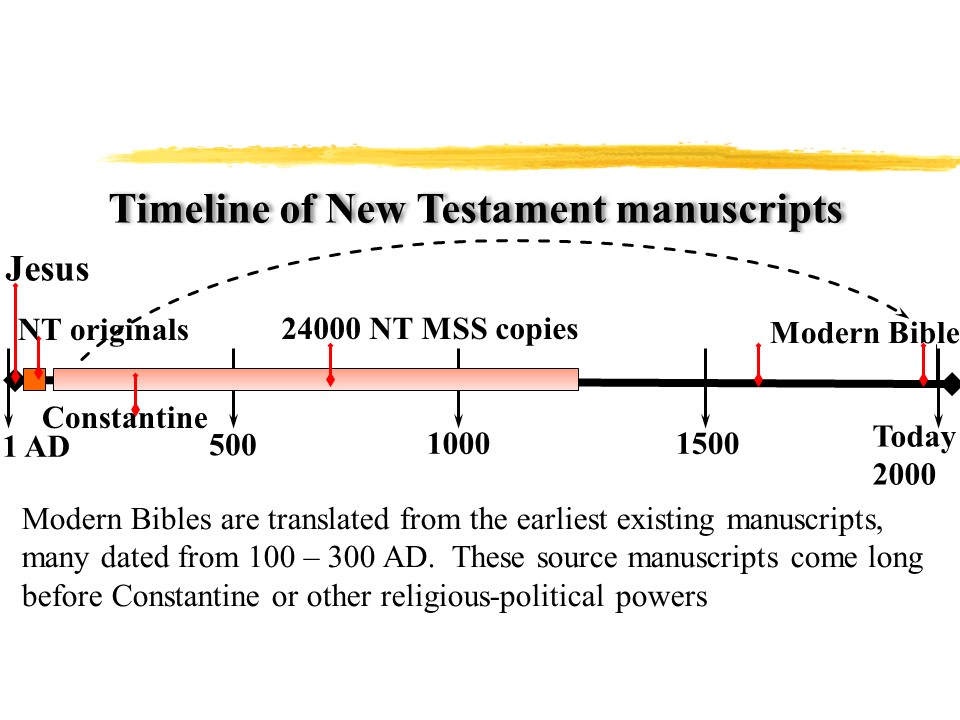Textual Criticism & the Bible
“Why should I even consider the Bible? It was written so long ago, has had so many translations and revisions done to it – it is most likely that its original message has been altered and misunderstood over the course of time.” The young man who asked me this question was intent, wondering if there was any reasonable answer to his skeptical outlook about the Bible.
The question my inquirer was asking is fairly straightforward – many of us ask it, and rightly so! It stems from what we know about the Bible. After all, it was written two thousand plus years ago. For most of these millennia there has been no printing press, photocopy machines or publishing companies. So the original manuscripts were copied by hand, generation after generation, as languages died out and new ones arose, as empires crumbled and new powers ascended. Since the original manuscripts have long been lost, how do we know that what we read today in the Bible is what the original authors actually wrote long ago? As my resolute friend pointed out to me, many young kids often play a game called telephone, wherein a message is whispered into someone’s ear, and (s)he in turn whispers this message into the next person’s ear until the message has traversed all participants in the game. Then the last person says the message out loud and all participants note how it has changed so much from its start at the beginning of the human chain. Can this game be comparable to the passing of the Bible through time, so that what we read today may be substantially different from the original writings?
Principles of Textual Criticism
Naturally this question is true of any ancient writing. This figure illustrates the process by which any such writing has been preserved over time.

Example of Stages in life of a hypothetical ancient document
This simplified diagram shows an example of an ancient document written at 500 BC. This original however does not last indefinitely, so before it decays, is lost, or destroyed, a manuscript (MSS) copy of it is made (1st copy). A professional class of people called scribes did the copying work. As the years advance, copies are made of the copy (2nd copy & 3rd copy). At some point a copy is preserved so that it is in existence (extant) today (3rd copy). In our example diagram this extant copy was made in 500 AD. This means that the earliest that we can know of the state of the document is only from 500 AD onwards. Consequently the period from 500 BC to 500 AD (labeled x in the diagram) is the period where we cannot make any copy verifications since all manuscripts from this period have disappeared. For example, if copying errors (intentional or otherwise) were made when the 2nd copy was made from the 1st copy, we would not be able to detect them as neither of these documents are available to compare against each other. This time period predating the origin of currently existing copies (the period x) is thus the interval of textual uncertainty. Consequently, a principle used help answer questions about textual reliability is to look at the length of this time span. The shorter this interval (labelled ‘x’ in the diagram) the more confidence we can place in the accurate preservation of the document to our modern day, since the period of uncertainty is reduced.
Of course, usually more that one manuscript copy of a document is in existence today. Suppose we have two such manuscript copies and in the same section of each of them we find the following translated phrase:

With few manuscipts (MSS) the textual base is small
The original author had either been writing about Joan OR about John, and the other of these manuscripts contains a copy error. The question is -Which one has the error? From the available evidence it is very difficult to determine.
Now suppose we found two more manuscript copies of the same work, as shown below:

The more manuscripts the greater the textual base
Now it is easier to deduce which manuscript probably has the error. It is more likely that the error is made once, rather than the same error repeated three times, so it is likely that MSS #2 has the copy error, and the author was writing about Joan, not John.
This simple example illustrates a second principle we can use to verify manuscript integrity – The more existing manuscripts that are available, the easier it is to detect & correct errors and to ascertain the content of the original.
So now we know two indicators used to determine the textual reliability of ancient documents: 1) measuring the time between original composition and earliest existing manuscript copies, and 2) counting the number of existing manuscript copies. Since these indicators pertain to any ancient writing we can proceed to apply them to both the Bible as well as other works of antiquity, as done in the tables below (1).
Textual Criticism of accepted ancient documents
| Author | When Written | Earliest Copy | Time Span | # |
| Caesar | 50 BC | 900 AD | 950 | 10 |
| Plato | 350 BC | 900 AD | 1250 | 7 |
| Aristotle* | 300 BC | 1100 AD | 1400 | 5 |
| Thucydides | 400 BC | 900 AD | 1300 | 8 |
| Herodotus | 400 BC | 900 AD | 1300 | 8 |
| Sophocles | 400 BC | 1000 AD | 1400 | 100 |
| Tacitus | 100 AD | 1100 AD | 1000 | 20 |
| Pliny | 100 AD | 850 AD | 750 | 7 |
* from any one work
These writers represent the major classical writers of antiquity – the writings that have shaped the development of Western civilization. On average, they have been passed down to us by 10-100 manuscripts that are preserved starting only about 1000 years after the original was written. From a scientific point-of-view this data can be considered our control experiment since it comprises data (classical writers) that are accepted and used by academics and universities world-wide.
Textual Criticism of the New Testament
The following table compares the Biblical (New Testament in particular) writings along these same points of interest (1). This can be considered our experimental data which will be compared to our control data, just like in any scientific investigation.
| MSS | When Written | Date of MSS | Time Span |
| John Rylan | 90 AD | 130 AD | 40 yrs |
| Bodmer Papyrus | 90 AD | 150-200 AD | 110 yrs |
| Chester * Beatty | 60 AD | 80 AD | 20 yrs |
| Codex Vaticanus | 60-90 AD | 325 AD | 265 yrs |
| Codex Sinaiticus | 60-90 AD | 350 AD | 290 yrs |
* Traditionally dated at 200 AD, new scholarship has argued for an earlier date of 80AD
The number of New Testament manuscripts is so vast that it would be impossible to list them all in a table. As one scholar (3) who spent years studying this issue states:
“We have more than 24000 MSS copies of portions of the New Testament in existence today… No other document of antiquity even begins to approach such numbers and attestation. In comparison, the ILIAD by Homer is second with 643 MSS that still survive”
A leading scholar at the British Museum (4) corroborates this:
“Scholars are satisfied that they possess substantially the true text of the principal Greek and Roman writers … yet our knowledge of their writings depends on a mere handful of MSS whereas the MSS of the N.T. are counted by … thousands”
A significant number of these manuscripts are extremely ancient. I own a book about the earliest New Testament documents. The Introduction starts with:
“This book provides transcriptions of 69 of the earliest New Testament manuscripts…dated from early 2nd century to beginning of the 4th (100-300AD) … containing about 2/3 of the new Testament text” (5)
This is significant since these manuscripts come before Roman Emperor Constantine (ca 325 AD) and the rise to power of the Catholic Church both of which are often accused of altering the biblical text. We can actually test this claim by comparing the alterations of the texts from before Constantine (since we have them) with those coming later. But when we do we find that they are the same. The message of the texts from 200 AD is the same as those from 1200 AD. Neither the Catholic Church, nor Constantine changed the Bible. That is not a religious statement, it is one based solely on scientific data.

Modern Bibles are based on the text of the earliest manuscripts
Implications of Textual Criticism re. the Bible
So what can we conclude from this? Certainly at least in what we can objectively measure (number of extant MSSs and time spans between original and earliest extant MSS) the New Testament is substantiated to a much higher degree than any other classical work of antiquity. The verdict to which the evidence pushes us is best summed up by the following quote (5):
“To be skeptical of the resultant text of the N.T. is to allow all of classical antiquity to slip into obscurity, for no other documents of the ancient period are as well attested bibliographically as the New Testament.”
What he is saying is that to be consistent, if we decide to doubt the reliability of the preservation of the Bible we may as well discard all that we know about classical history in general – and this no informed historian has ever done. We know that the Biblical texts have not been altered as eras, languages and empires have come and gone since the earliest extant MSSs pre-date these events. For example, we know that no overly zealous medieval monk added in the miracles of Jesus to the Biblical account, since we have manuscripts that pre-date the medieval monks and all these pre-dated manuscripts also contain the miraculous accounts of Jesus.
Video of University Presentation on Bible text reliability
Here is a short video of a presentation I did at a university on the textual reliability of the New Testament.
The Old Testament is different enough that it warrants its own discussion which is highlighted in the 7 minute video here.
What about translation in Bible Versions?
Bible ‘versions’ are simply tanslations of the original Greek or Hebrew text into English. Because English can be expressed in many ways, the differences between versions are due to differences in translation styles (though there is a slightly different Greek text Textus Receptus used for the King James Version). So what about the errors involved in translation, and the fact that there are so many different versions of the Bible today? Does this not show that it is impossible to accurately determine what the original authors actually wrote? Due to the vast classical literature that was written in Greek (original language of the New Testament), it has become possible to precisely translate the original thoughts and words of the original authors. In fact the different modern versions attest to this. For example, compare the well-known verse Romans 6:23 (see here for an explanation of this verse) in the some popular Bible versions, and note the slight variance in wording, but consistency in idea and meaning:
“For the wages of sin is death, but the gift of God is eternal life in Christ Jesus our Lord.” New International Version (NIV)
Sin pays off with death. But God’s gift is eternal life given by Jesus Christ our Lord. Contemporary English Version (CEV)
“For the wages of sin is death; but the gift of God is eternal life through Jesus Christ our Lord.” King James Version (KJV)
For the wages of sin is death, but the free gift of God is eternal life in Christ Jesus our Lord. English Standard Version (ESV)
“For the wages of sin is death, but the free gift of God is eternal life in Christ Jesus our Lord.” New American Standard Version (NASB)
For the wages of sin is death, but the free gift of God is eternal life through Christ Jesus our Lord. New Living Translation (NLT)
For the wages of sin is death, but the free gift of God is eternal life in Christ Jesus our Lord. Revised Standard Version (RSV)
In this Bible comparison you can see that there is no disagreement between the translations – they say exactly the same thing with only slightly different word usage.
To summarize, neither time nor translation has kept the original ideas and thoughts as expressed in the original Biblical manuscripts hidden from us. We can know that the Bible today accurately reads what the authors actually wrote.
It is important to realize what this little study does and does not show. It does not prove that the Bible is necessarily the Word of God, nor that it is even true. It simply shows that though the original ideas of the Biblical authors have been accurately conveyed to us today. This does not prove that these original ideas are correct (or even that they are from God –asked here). But understanding the textual reliability of the Bible provides a start-point from which one can start seriously investigating the Bible to see if some of these other questions can also be answered, and to see what the theme of the Bible is. I hope that this introductory article may encourage you to take a good look at the ‘Book’. You may have additional questions about the King James Version (see here) or about Constantine and the role he played in how the Bible has come to us – take a look at this here.
Good places to start to examine the Bible are the accounts of Abraham and the sacrifice of Isaac as well as the Passover account. Both of these will introduce you to the theme of the Bible and will get you started to consider whether this message may really be from God or not.